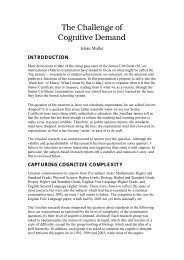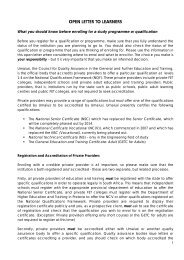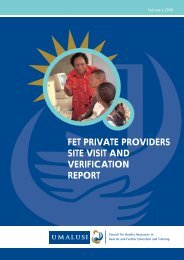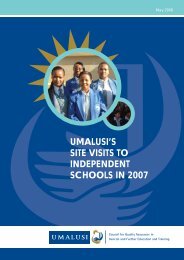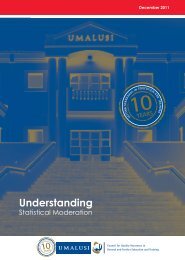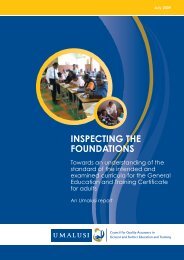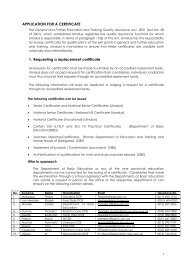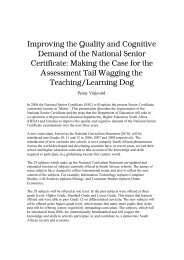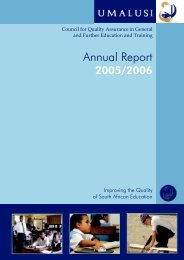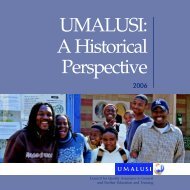Umalusi AET Report
Umalusi AET Report
Umalusi AET Report
- No tags were found...
You also want an ePaper? Increase the reach of your titles
YUMPU automatically turns print PDFs into web optimized ePapers that Google loves.
The most recent total enrolment fi gures, for 2006, suggest that the total number of learners enrolledin <strong>AET</strong> programmes in the sample of 50 providers is between 17 600 and 20 700. The total varies,depending on which set of fi gures is used, ie those that relate to gender, age or part- and full-timeattendance. By far the majority, or over 80% of learners are enrolled in part-time programmes andthe remainder registered as full-time learners. Just over half of learners are enrolled on programmesthat lead to NQF-registered qualifi cations, about one third on non-NQF-registered programmesand the least number on “short” courses. Figures on drop-out rates showed some anomalies and nilreturns. However, the most recent estimation, also for 2006, indicates a drop-out rate of between 11and 22%.2006 <strong>AET</strong> learners: part- and full-time attendancePart time Full time TotalNQF-registered 7 618 1 333 8 951programmesNon-NQF programmes 5 427 421 5 848Short courses 2 191 695 2 886Total 15 236 2 449 17 685GENDERThe fi gures on enrolment suggest that the enrolment of men seems to be consistently higher onNQF-registered and non-NQF programmes, while this was not the case for short courses. Theenrolment of men and women on short courses appeared to be fairly similar, with some yearsshowing a higher enrolment of women and other years that of men.Generally more men than women are enrolled in private <strong>AET</strong> centres. In 2006, the fi gures indicatinggender showed that of a total of 20 730 learners, 11 655 were men and 9 075 women. This suggestsan enrolment of male learners of about 56%. This places private providers in the same position asmost workplace ABET programmes in South Africa, as opposed to those that are community based.Generally, workplace ABET programmes have a higher enrolment of men than women, while in thecommunity-based sector the enrolment of women is often much higher than that of men.AGE GROUPSPrivate <strong>AET</strong>: age groups of learnersAge No. aged 17 – 25 yrs No. aged 26 – 35 yrs No. aged 36 and olderNQF programmes 1 005 2 431 5 331Non-NQF programmes 4 340 3 572 1 519Short courses 592 1 135 923Total 5 937 7 138 7 773The fi gures submitted on ages of learners did not show unexpected or remarkable fi ndings, otherthan there were possibly more older learners than anticipated. <strong>AET</strong> is often a catchment forout-of-school youth. Yet the largest cohort of learners in the sample was the 36 years and oldergroup, though not by a wide margin. This serves to affi rm the role of the older learner in <strong>AET</strong> andlifelong learning, especially with policy and planning for the sector. These statistics also suggest15



